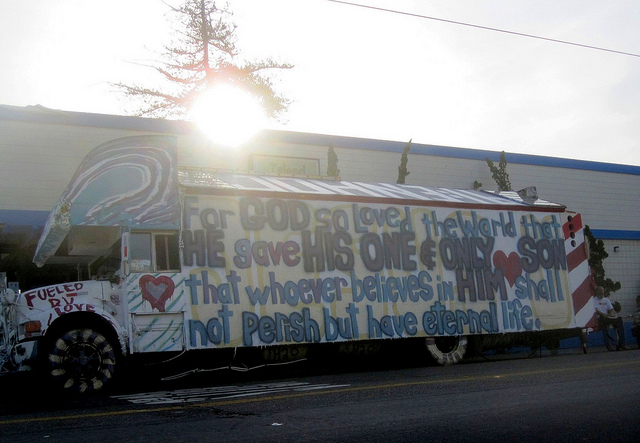Lectionary Reflection for the Fourth Sunday in Lent, Year B
March 15, 2015
Indeed, God did not send the Son into the world to condemn the world, but in order that the world might be saved through him. John 3:17
This verse follows what many might assume is one of the most quoted passages in the entire Bible. But according to an infographic in Christianity Today John 3:16 didn’t even make it as one of the top ten most “shared” verses list for that year. Nope. Not even a top ten slot. It did, however, earn the number one spot for most searched verse on Bible Gateway, a popular website that tallied 456 million visits and 1.5 billion page views in 2013. So clearly, John 3:16 is important to a whole host of folks in addition to those who emblazon it on their chests and signs at professional sporting events.
So what about verse 17? Why is it so seldom linked to John 3:16? After all, it clearly belongs with 3:16 in the context John’s thoughts. In fact, it is crucial to the meaning of this week’s gospel lesson. We do this passage a disservice when we excise John 3:16 out of this difficult and paradoxical setting of Jesus’ nighttime conversation with the Pharisee Nicodemus. A learned and  devout man, Nicodemus was having a tough time grasping this concept of being “born again” and of just how much God loves all of creation–enough to come into the world as the Son and be lifted up, exalted in such a scandalous and countercultural way.
devout man, Nicodemus was having a tough time grasping this concept of being “born again” and of just how much God loves all of creation–enough to come into the world as the Son and be lifted up, exalted in such a scandalous and countercultural way.
Jesus goes on to say that we humans run from the light; the image that keeps coming to mind is cockroaches scurrying when the lights are turned on. Being exposed, being vulnerable, even in the loving and grace-filled light of Christ, runs counter to our human nature. We want to keep our evil desires, our sinful expressions, and our selfish ways hidden in the shadows. In fact, we’re pretty adept at adapting to the darkness and fooling ourselves into all sorts of pretty little lies and heady rationalizations.
We convince ourselves that Jesus came because God loves us and other people like us. Everything is fine and dandy as long as our notions of who is worthy of God’s love aren’t challenged too much. But here’s the thing: John 3:17 does challenge us because we learn that God doesn’t want anyone to be destroyed, that all of creation is worthy of salvation.
Jesus invites us to remember Moses lifting the up the bronze serpent for the Israelites to gaze upon in order to be healed from the deadly bites of the snakes sent to punish them. He stretches the image to himself, and we know the rest of the story and what that means in terms of crucifixion and resurrection. Condemnation becomes salvation in a paradoxical turn of image (and event!) that requires a response to live in the light, to let the grace wash over us, and to be people who choose exposure rather than hide in the shadows of our sinful natures. The real rub, of course, comes when we realize that there’s room in the light for all of God’s beloved creation.
 We’d better make room for sinners of every ilk and stripe, for all have sinned and fallen short of the divine mark. We don’t get to pick and choose our company in the light of God’s love. Yep, you might be standing shoulder to shoulder with a convicted killer, a prostitute, or someone whose politics and world view may set your teeth on edge. No, the way of God doesn’t make sense when compared to the way the world orders the good, the bad, and the ugly, so don’t even bother trying. To do so will only leave you slinking off in the darkness, scratching your head with Nicodemus and others who try to make sense of God’s abundant love and grace.
We’d better make room for sinners of every ilk and stripe, for all have sinned and fallen short of the divine mark. We don’t get to pick and choose our company in the light of God’s love. Yep, you might be standing shoulder to shoulder with a convicted killer, a prostitute, or someone whose politics and world view may set your teeth on edge. No, the way of God doesn’t make sense when compared to the way the world orders the good, the bad, and the ugly, so don’t even bother trying. To do so will only leave you slinking off in the darkness, scratching your head with Nicodemus and others who try to make sense of God’s abundant love and grace.
Go ahead. Step into the light, make room for other sinner/saints, and get to work. God does love the world–you, me, and all the rest of creation–and is on the move restoring everything to its right order. That means we, too, have some work to do, dearly beloved. Let’s get to it.
In Worship
How do we look unflinchingly on that which would cause our death and destruction and also realize that looking leads to life? This was the case of the Israelite in our Old Testament lesson today (Numbers 21:4-9). As Christians, we look at the cross and its scandal and we see life. In this symbol we see grace, mercy, and love. It’s both counterintuitive and paradoxical. Looking at the cross forces us to face our own desire to dwell in life’s dark places rather than confront tough realities exposed by the light of Christ. Many liturgical churches cover the cross with a purple or black veil during Lent as a reminder that our sin separates us from God. We dwell for a time without the symbol of our salvation and are thus reminded of the power of Christ’s light when we come to Easter. How might you incorporate a focus on this image in your hymnody and prayer petitions?
With Youth
Consider a focus on verse ten of this week’s epistle lesson: For we are what he has made us, created in Christ Jesus for good works, which God prepared beforehand to be our way of life. This is a powerful statement of purpose and meaning. We don’t try to do good works to earn salvation; we were created for good works as a way of life to glorify God who loves us beyond all measure. Invite youth to consider how this might inform a purpose statement or lifestyle strategy. How might it counter the values that the world and contemporary culture lifts up as desirable?
With Children
For the children’s sermon today you will need a strong flashlight. Ask the children how you find your way in the dark. What do you need? Show them the flashlight and talk about how its beam makes a path to follow, a light to show you the way to your destination. Jesus doesn’t want us to wait around in the dark–lost and lonely. His love shines a light that we can follow, that we can stand in, and that can lead us to our ultimate destination, which is wherever he is. If you can get inexpensive pen lights at the dollar store or from a retailer that offers them as giveways, give each child a small flashlight as a reminder that Jesus wants them to walk in his light. If you know the hymn “Walking in the Light of God” you might invite the children to walk around in the beam of the flashlight while singing this African hymn
Photos; Eric Golub, Francis Gimenez, and James Trosh, Creative Commons. Thanks!




Thanks for this today, Sharron. I see an “ouch” moment in my sermon on Sunday, thanks to your illustration.
So many of the children’s messages I saw for this passage used John 3:16 as their focus. Thanks for your broader perspective!